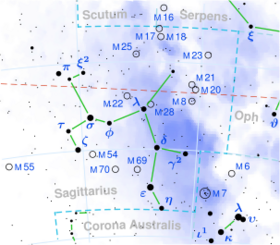Astronomy:W Sagittarii
| Observation data Equinox J2000.0]] (ICRS) | |
|---|---|
| Constellation | Sagittarius |
| Right ascension | 18h 05m 01.22643s[1] |
| Declination | −29° 34′ 48.3222″[1] |
| Apparent magnitude (V) | 4.29 - 5.14[2] |
| Characteristics | |
| Aa1 | |
| Spectral type | F4 - G2Ib[2] |
| U−B color index | +0.52[3] |
| B−V color index | +0.78[3] |
| Variable type | δ Cep[2] |
| Aa2 | |
| Spectral type | A5V - F5V[4] |
| Ab | |
| Spectral type | A0 V[5] |
| Astrometry | |
| Proper motion (μ) | RA: +4.372[1] mas/yr Dec.: −5.588[1] mas/yr |
| Parallax (π) | 2.365 ± 0.1765[1] mas |
| Distance | 1,400 ± 100 ly (420 ± 30 pc) |
| Absolute magnitude (MV) | −3.76[5] |
| Orbit[4] | |
| Primary | Aa1 |
| Companion | Aa2 |
| Period (P) | 4.33±0.01 yr |
| Semi-major axis (a) | 12.9 ± 0.3" (5.67 ± 0.13 AU) |
| Eccentricity (e) | 0.41 ± 0.02 |
| Inclination (i) | 7.0 ± 0.8° |
| Longitude of the node (Ω) | 68.4 ± 4.0° |
| Periastron epoch (T) | 2004.16 ± 0.01 |
| Argument of periastron (ω) (secondary) | 328.0 ± 1.3° |
| Orbit[5] | |
| Primary | Aa |
| Companion | Ab |
| Period (P) | 172.9 yr |
| Semi-major axis (a) | 63 AU |
| Details | |
| Aa | |
| Mass | 5.8[5] M☉ |
| Radius | 61.0[6] R☉ |
| Luminosity | 2,690[5] L☉ |
| Surface gravity (log g) | 1.50 - 2.15[7] cgs |
| Temperature | 5,380 - 6,474[7] K |
| Metallicity [Fe/H] | +0.02[8] dex |
| Aa2 | |
| Mass | 1.4 - 2.0[4] M☉ |
| Ab | |
| Mass | 2.2[5] M☉ |
| Other designations | |
| Database references | |
| SIMBAD | data |
W Sagittarii (W Sgr, Gamma1 Sagittarii (γ1 Sgr)) is a multiple star system star in the constellation Sagittarius, and a Cepheid variable star.
W Sagittarii is an optical line-of-sight companion nearly a degree from the much brighter γ2 Sgr (Al Nasl) which marks the nozzle or spout of the teapot asterism.
System
W Sgr is listed as component A of a multiple star system catalogued as ADS 11029 and WDS J18050-2935. Components B and C are at 33" and 46" respectively and both are 13th magnitude. They are purely optical companions, not physically associated with W Sgr.[9]
Component A, W Sgr, is itself a triple star system, with the components referred to as W Sgr Aa1, Aa2, and Ab.[10] These have also been referred to as components Aa, Ab, and B respectively.[9] The outer companion Ab has been resolved at a separation of 0.14" and is over 5 magnitudes fainter than the primary supergiant. The inner components can only be identified spectroscopically by their radial velocity variations. The primary is a 6 M☉ yellow supergiant, while the secondary is an early F main sequence star with a mass less than 1.4 M☉.[9]
Variability
The supergiant component W Sgr Aa1 is a variable star which pulsates regularly between magnitudes 4.3 and 5.1 every 7.59 days. During the pulsations, that temperature and spectral type also vary. It is classified as a Classical Cepheid (δ Cephei) variable.[5]
References
- ↑ 1.0 1.1 1.2 1.3 1.4 Brown, A. G. A. (2021). "Gaia Early Data Release 3: Summary of the contents and survey properties". Astronomy & Astrophysics 649: A1. doi:10.1051/0004-6361/202039657. Bibcode: 2021A&A...649A...1G. Gaia EDR3 record for this source at VizieR.
- ↑ 2.0 2.1 2.2 Samus, N. N. et al. (2009). "VizieR Online Data Catalog: General Catalogue of Variable Stars (Samus+ 2007-2013)". VizieR On-line Data Catalog: B/GCVS. Originally Published in: 2009yCat....102025S 1. Bibcode: 2009yCat....102025S.
- ↑ 3.0 3.1 Ducati, J. R. (2002). "VizieR Online Data Catalog: Catalogue of Stellar Photometry in Johnson's 11-color system". CDS/ADC Collection of Electronic Catalogues 2237. Bibcode: 2002yCat.2237....0D.
- ↑ 4.0 4.1 4.2 Benedict, G. Fritz; McArthur, Barbara E.; Feast, Michael W.; Barnes, Thomas G.; Harrison, Thomas E.; Patterson, Richard J.; Menzies, John W.; Bean, Jacob L. et al. (2007). "Hubble Space Telescope Fine Guidance Sensor Parallaxes of Galactic Cepheid Variable Stars: Period-Luminosity Relations". The Astronomical Journal 133 (4): 1810. doi:10.1086/511980. Bibcode: 2007AJ....133.1810B.
- ↑ 5.0 5.1 5.2 5.3 5.4 5.5 5.6 Evans, Nancy Remage; Bond, Howard E.; Schaefer, Gail H.; Mason, Brian D.; Karovska, Margarita; Tingle, Evan (2013). "Binary Cepheids: Separations and Mass Ratios in 5 M ⊙ Binaries". The Astronomical Journal 146 (4): 93. doi:10.1088/0004-6256/146/4/93. Bibcode: 2013AJ....146...93E.
- ↑ Groenewegen, M. A. T. (2007). "The projection factor, period-radius relation, and surface-brightness colour relation in classical cepheids". Astronomy and Astrophysics 474 (3): 975–981. doi:10.1051/0004-6361:20078225. Bibcode: 2007A&A...474..975G.
- ↑ 7.0 7.1 Luck, R. E.; Andrievsky, S. M. (2004). "Phase-dependent Variation of the Fundamental Parameters of Cepheids. I. Periods from 6 to 10 Days". The Astronomical Journal 128 (1): 343–356. doi:10.1086/420991. Bibcode: 2004AJ....128..343L.
- ↑ Marsakov, V. A.; Koval', V. V.; Kovtyukh, V. V.; Mishenina, T. V. (2013). "Properties of the population of classical Cepheids in the Galaxy". Astronomy Letters 39 (12): 851. doi:10.1134/S1063773713120050. Bibcode: 2013AstL...39..851M.
- ↑ 9.0 9.1 9.2 Evans, Nancy Remage; Massa, Derck; Proffitt, Charles (2009). "Massive Star Multiplicity: The Cepheid W Sgr". The Astronomical Journal 137 (3): 3700. doi:10.1088/0004-6256/137/3/3700. Bibcode: 2009AJ....137.3700E.
- ↑ Mason, Brian D.; Wycoff, Gary L.; Hartkopf, William I.; Douglass, Geoffrey G.; Worley, Charles E. (2001). "The 2001 US Naval Observatory Double Star CD-ROM. I. The Washington Double Star Catalog". The Astronomical Journal 122 (6): 3466–3471. doi:10.1086/323920. Bibcode: 2001AJ....122.3466M.
- ↑ "MAST: Barbara A. Mikulski Archive for Space Telescopes". Space Telescope Science Institute. https://mast.stsci.edu/portal/Mashup/Clients/Mast/Portal.html.
 |



